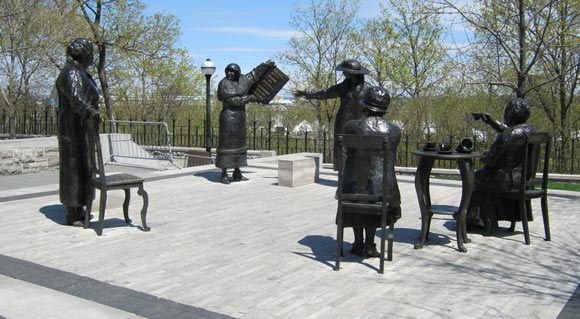Ordain Women is hosting a weeklong celebration of women’s history in recognition of this years theme, “Honoring our past, envisioning our future.” Each day this week we will be sharing a new post highlighting stories of women from all over the world, submitted by you. If you would like to share women’s history from your area, you can send your submission to: ordainmormonwomen@gmail.com. This post is the first installment in this series.
On Parliament Hill in Canada’s capital city of Ottawa, you’ll find a group of five statues with the title “Women are Persons!”
Since it’s installation in 2000 I have loved this statue. I even recently dragged my kids to it, on a rainy day, so that we could take a picture with the Famous Five to send to my niece who had asked for help doing a school project. As we stood there, drenched to the bone, I am sure I must have said something to them about the importance of remembering the courage of those who have come before us, of remembering that the rights and privileges we enjoy were achieved only through the hard work of others. In doing some research for this blog post I came across the following statement:
“The empty chair by Emily Murphy invites visitors to sit and join in the great accomplishment of the Famous Five and of women all over Canada.”
But today, as I think of sitting in that chair, what I feel is privilege.
The work of the Famous Five —Emily Murphy, Irene Marryat Parlby, Nellie Mooney McClung, Louise Crummy McKinney and Henrietta Muir Edwards – is to be celebrated. And the unveiling of the monument in Ottawa not only represented the first time the grounds held a statue honouring woman (excluding monarchs), it was also the first time a monument on Parliament Hill was created by a woman.
However, only some women won the right to fully participate in the political sphere that day. Many did not.
First Nations people in most parts of Canada had the right to vote from Confederation (1867) on – but only if they gave up their status under the Indian Act. And so the practice of enfranchisement in First Nations communities meant that legally an individual could either be an Indian or a voter.
Additionally, while the Dominion Elections Act recognized that every eligible Canadian over 21 – male or female could vote in federal elections, the Act also contained a clause stating that people disenfranchised by a province “for reasons of race” would also be excluded from the federal franchise. In British Columbia, people of Japanese and Chinese origin, as well as “Hindus” – a description applied to anyone from the Indian subcontinent who was not of Anglo-Saxon origin, regardless of whether their religious affiliation was Hindu, Muslim, Sikh or any other.
Racial exclusions for voting were not lifted until 1947 against Chinese and Indo-Canadians and until 1948 for Japanese-Canadians.
The right to vote was not extended unconditionally to First Nations until 1960 (for federal elections). Their provincial suffrage was only recognized a decade later. Members of Canada’s First Nations were the last Canadians to be afforded the right to vote.
And so, how will I celebrate the accomplishments of the past while remembering those that were left behind? What will I do with my privilege?
In June 2015, after seven years of collecting evidence the Truth and Reconciliation Commission of Canada (TRC) released its 388-page executive summary, centred on the TRC’s 94 recommendations and written as a call to action. Justice Murray Sinclair, the Chair of the TRC says:
“Reconciliation is about forging and maintaining respectful relationships. There are no shortcuts.”
In Mormon culture we often “challenge” each other to go out and do something – a call to action. And so today the call to action imprinted on my heart, is that of reconciliation, of forging and maintaining respectful relationships.
As one gesture toward reconciliation, I am going to do some searching and reading. I am going find stories of Aboriginal heroines, and I am going to tell their stories to my children.
This post was submitted by Mary Johnson who lives in Ottawa-Gatineau, Canada.






